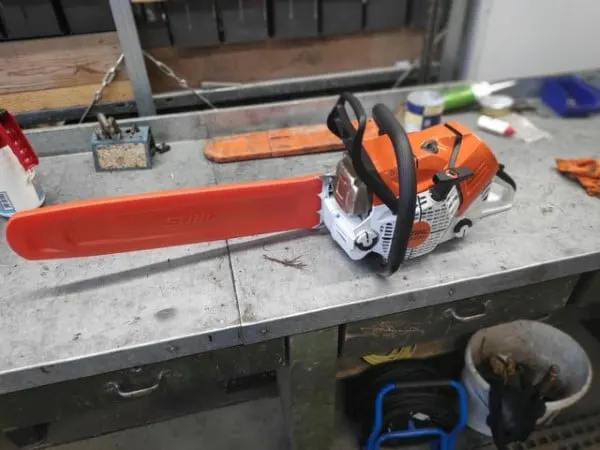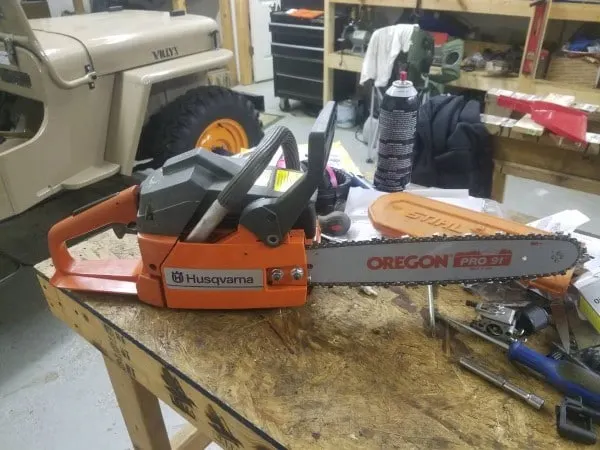When your chainsaw doesn’t start, you should check a few things first. The most likely problem is that the engine has flooded because of an open choke or over-priming in the fuel carburetor.
Flooded carbs can be quite frustrating. You never know whether to choke or not as you pull on that starter rope in the summer heat.
When the chainsaw’s carburetor floods, there is excess fuel in it that pushes out all of its oxygen needed for combustion. Cleaning a flooded chamber on your saw can be done by simply vacuuming up some water that makes room for oxygen.
The process entails cleaning both dirt particles and liquid residue off the surface while also removing anything built up around valves. Read this article to know how to unflood a chainsaw.
- Reasons Behind a Flooded Chainsaw
- Some Tips Before Unflooding A Chainsaw
- 10 Steps To Unflood A Chainsaw
- Step 1: Check The Manufacturer's Guide
- Step 2: Place The Chainsaw On A Flat Surface
- Step 3: Remove The Top Cover Of Engine
- Step 4: Locate The Spark Plug
- Step 5: Unscrew The Spark Plug
- Step 6: Dry Out The Fuel On Spark Plug
- Step 7: Unflood The Chainsaw
- Step 8: Clean Excess Fuel
- Step 9: Reinstalling
- Step 10: Time To Start the Chainsaw
- Conclusion:

Reasons Behind a Flooded Chainsaw
Before we jump into the deep discussion of unflooding a chainsaw, we must know what causes a chainsaw to be flooded. The flooded chainsaw occurs when too much fuel is in the combustion chamber.
The problem with too much fuel is that there’s not enough space for oxygen when the spark plug attempts to ignite the gas.
In simple words, there is not enough air that is crucial for igniting the gas, creating a spark plug. A flooded chainsaw is the biggest problem that only leaves you with pulling the cord over and over again, resulting in high blood pressure or exhaustion.
Don’t freak out in this situation, as we will give a step-by-step guide to unflood such chainsaws. But first, look at the problems which caused your chainsaw to flood in the first place.
- You over choked the chainsaw, which in turn flooded it.
- You used the choke when the chainsaw was not in its run position.
- A warmup engine never welcomes the choke, but you deliberately or accidentally did it.
- No gas cap was present on the fuel fill port.
- The gas was left in the tank for too long.
- After using the chainsaw, leave it for some time without choking it so that it may start to back up. Otherwise, it will be flooded.
Another thing to notice here is that you can also guess that a chainsaw is flooded by a strong odor of gasoline arising from its carburetor. Let’s head to the solution, i.e., to an unflood chainsaw.
Some Tips Before Unflooding A Chainsaw
Flooding is one of the most common problems with gas-powered tools, including chainsaws. There are several ways to reduce flooding without taking your saw apart or purchasing expensive accessories – follow these simple tips.
- Ensure that your chainsaw’s engine has fresh petrol in it. Am old mixture of gas and oil will put a great load on the engine, becoming a hurdle to start it.
- Drain the old fuel and replace it with the fresh one to succeed in your attempt of unflooding chainsaw.
- Get yourself equipped with a Spark plug wrench or combination wrench, a cloth to wipe off excessive water.
- You may also start a flooded chainsaw without any tool (in case no tool is available around you at times), which we will also be discussing ahead.

10 Steps To Unflood A Chainsaw
The following 10 steps are the easiest to start any flooded chainsaw. They are reliable, easy and quick and get your machine fixed within no time.
Step 1: Check The Manufacturer’s Guide
Before you start, make sure to check your manual and follow any safety instructions. Precaution is the foremost thing to consider before dealing with any machinery in your arsenal!
Step 2: Place The Chainsaw On A Flat Surface
When you first start unflooding your chainsaw, ensure that the surface is clean and flat. Place it on a sturdy table or workbench, so its blade doesn’t touch anything else.
Step 3: Remove The Top Cover Of Engine
To remove the cover of your chainsaw, move it to a lower position and lift it off. There are many different ways to do this, depending on your type. So read through them all before taking yours apart.
Step 4: Locate The Spark Plug
After removing the engine’s cover, you have to locate the spark plug (take guidance from an operator or manual for it).
You can eliminate any excess fuel from your chainsaw; you have to remove its spark plug. Be very careful while doing it and make sure you don’t have any piece of cloth, i.e., gloves, in your hands.
You may need a wrench or tool for this purpose. Now you are going to detach the high voltage cap and spark plug. Don’t exert much force; instead, hold gently and pull it away.
Step 5: Unscrew The Spark Plug
Unscrew the spark plug with an adjustable wrench. It would be best to use a combination wrench that comes inside the chainsaw package.
Use one end of the wrench to loosen the spark plug by turning it counterclockwise. Unscrew it with your hand, and you are all done! Don’t forget to press the choke control level to deactivate the fuel supply in the chainsaw engine.
Step 6: Dry Out The Fuel On Spark Plug
Once you are done unscrewing the spark plug, now is the time to dry out any fuel present on it. You can do it easily by any one of the following methods:
- Wiping with a piece of cloth or paper towel
- using an air compressor to blow air over the electrode
- pulling the starting cord of the chainsaw
Step 7: Unflood The Chainsaw
Disconnecting the spark plug from its wire before removing the excess fuel from the chamber. Take this necessary step to avoid vapor ignition. Pull the starting cord 3-4 times to remove excess fuel and allow oxygen to make its space.
Step 8: Clean Excess Fuel
Put a paper towel in the spark plug hole positioned at the cylinder and turn over the saw (with the engine positioned down). Again, pull the starting cord firmly but not with all your might. Allow the excess fuel to get absorbed by the napkin. Fix the spark plug back into its position with the help of a wrench.
Step 9: Reinstalling
Reinstall the high-voltage cap and the top cover of the engine back to its position. Now is the time to start the chainsaw again but make sure the carburetor throttle is open. It is necessary to remove any residual fuel left inside the combustion chamber.
Step 10: Time To Start the Chainsaw
Fully open your saw’s choke lever and then bring it back to the half-open position. Pull slightly hard on the starter rope 3 times with quick bursts ensuring the trigger is in your hand. Your chain saw starts running!
Release the trigger at this time to let the engine come back to idle speed and turn the choke off.
>> Related Pots:
- Why Does My Chainsaw Cut Crooked? (4 Reasons & 3 Solutions)
- How To Store A Chainsaw In 8 Easy Steps?
- How To Untangle Chainsaw Chain In 5 Easy Steps
Conclusion:
If you have a problem with your flooded chainsaw, then this article is your savior. A flooded chainsaw can cause great problems, and you have to unflood it as soon as possible to avoid potentially expensive repairs. This article is a complete guide to help you do it all independently!
We hope you’ll find it useful. Don’t forget to leave your feedback if it does!
